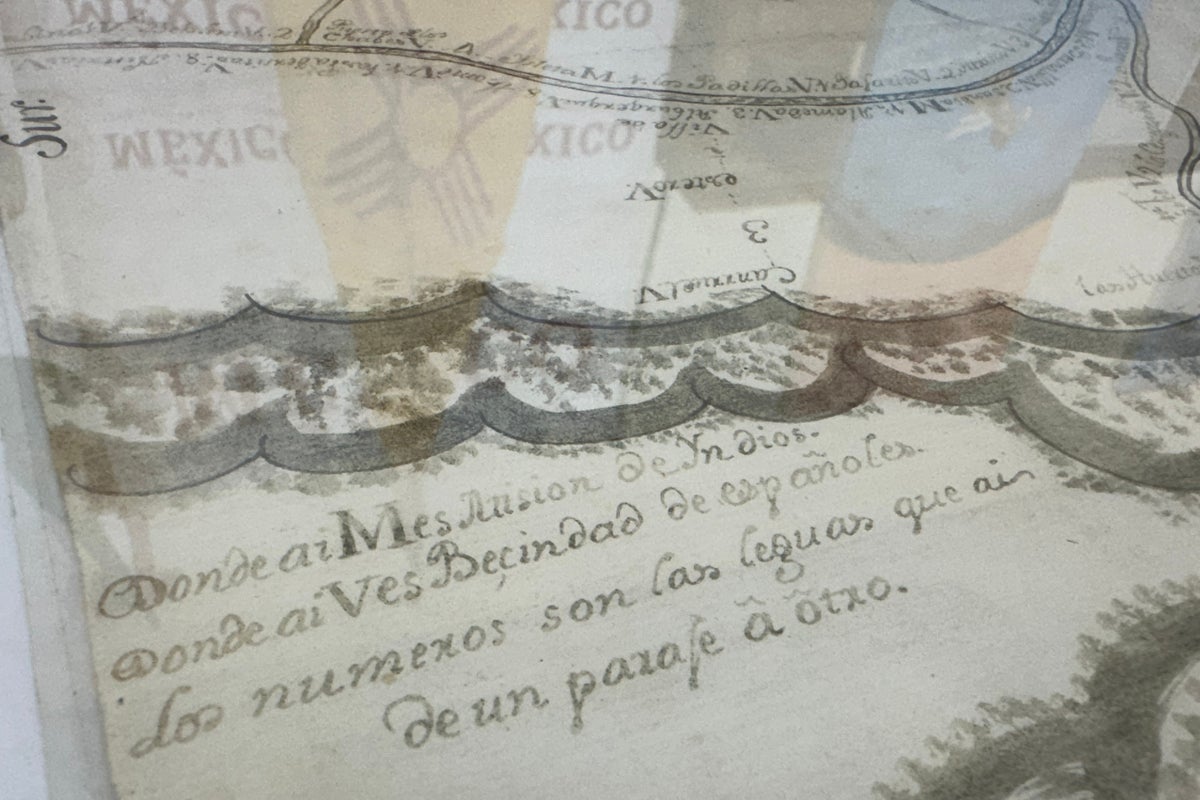Science
Historic Map Returns to Mexico After Years of Recovery Efforts

A centuries-old map, integral to the history of Spanish settlement in present-day Mexico and the southwestern United States, has been returned to the Mexican government. This significant event took place on October 10, 2023, marking the culmination of a prolonged effort to reclaim the historic document. The handover occurred at the Mexican consulate in Albuquerque, New Mexico, where FBI agents and Mexican officials were joined by historians and archivists for a celebratory occasion.
FBI Special Agent in Charge Justin Garris emphasized the importance of the map, explaining that it represented far more than mere ink on paper. “This document not only enriches our collective memory but also strengthens the ties that unite Mexico and New Mexico through a shared history,” stated Patricia Pinzón, the Consul of Mexico in Albuquerque. She highlighted the Camino Real de Tierra Adentro, a historic 1,600-mile (2,560-kilometer) route that connected Mexico City to Santa Fe, as a significant feature depicted on the map.
The map artistically includes names of communities along this vital route, with additional lines indicating rivers and Native American community names incorporated into the landscape representation. Unlike contemporary maps, this one is oriented with north to the right and west at the top, a distinctive characteristic that reflects its historical context.
This recovery is part of a broader initiative, according to Pinzón, as Mexico has reclaimed thousands of archaeological and cultural items in recent years. Just last month, a priceless manuscript page signed by Spanish conquistador Hernán Cortés was returned to Mexico. The map was discovered missing in 2011 by archivists in Mexico City, who noted that it was among 75 items taken from the national archives, including clear evidence of tampering in the form of a scar inside one volume where pages had been removed.
After five years without leads, hope was rekindled when a librarian from the Fray Angélico Chávez History Library at the New Mexico History Museum in Santa Fe contacted authorities while conducting background research on a map presented for sale. The librarian’s findings suggested the document may have been stolen, prompting further investigation, as narrated by Billy Garrett, executive director of the museum.
Mexican archivists utilized negatives and microfilm copies to authenticate the document, ultimately leading to a resolution of the legal complexities surrounding the return process. Throughout this time, Garrett indicated that the library safeguarded the map in a controlled environment. Made from rag pulp paper, it was kept secure while the FBI held it for nearly a year until the official handoff.
“It’s gratifying to see it returned to its rightful owners; we were pleased to take care of it in the interim,” Garrett remarked. Federal investigators noted that the map’s appearance in Santa Fe is not surprising, as the city is a hub for dealers and collectors focused on Native American and Spanish colonial art. They confirmed that no charges would be filed related to the map’s theft.
During the ceremony, Manuel García y Griego, a history professor at the University of New Mexico, reflected on his past encounters with the map while researching at the Archivo General de la Nación in Mexico City. He expressed the significance of the map and its recovery, noting that he and fellow researcher Joseph Sánchez independently recognized its importance decades earlier.
Sánchez presented several older maps during the event, emphasizing that the recovered map is just one piece of a larger historical narrative that extends beyond the current borders of New Mexico. He remarked, “This is something quite unique and illustrates a different type of settlement pattern.”
Santa Fe Mayor Alan Webber also attended the event, taking a moment to appreciate the map’s intricate details. He underscored the historical significance of Santa Fe, founded in 1610 as the seat of Spain’s Nuevo Mexico, stating, “We live history. It’s not just a thing of the past; it’s part of our daily lives.” For Webber, the map encapsulates a rich story built upon generations of families and histories, highlighting the uniqueness of New Mexico’s cultural landscape.
The return of this map not only enriches Mexico’s cultural heritage but also reinforces the enduring connections between Mexico and the southwestern United States, a testament to shared histories that continue to resonate today.
-

 Entertainment3 months ago
Entertainment3 months agoAnn Ming Reflects on ITV’s ‘I Fought the Law’ Drama
-

 Entertainment4 months ago
Entertainment4 months agoKate Garraway Sells £2 Million Home Amid Financial Struggles
-

 Health3 months ago
Health3 months agoKatie Price Faces New Health Concerns After Cancer Symptoms Resurface
-

 Entertainment3 months ago
Entertainment3 months agoCoronation Street’s Carl Webster Faces Trouble with New Affairs
-

 Entertainment3 months ago
Entertainment3 months agoWhere is Tinder Swindler Simon Leviev? Latest Updates Revealed
-

 Entertainment4 months ago
Entertainment4 months agoMarkiplier Addresses AI Controversy During Livestream Response
-

 Science1 month ago
Science1 month agoBrian Cox Addresses Claims of Alien Probe in 3I/ATLAS Discovery
-

 World2 weeks ago
World2 weeks agoBailey Announces Heartbreaking Split from Rebecca After Reunion
-

 Health4 months ago
Health4 months agoCarol Vorderman Reflects on Health Scare and Family Support
-

 Entertainment4 months ago
Entertainment4 months agoKim Cattrall Posts Cryptic Message After HBO’s Sequel Cancellation
-

 Entertainment3 months ago
Entertainment3 months agoOlivia Attwood Opens Up About Fallout with Former Best Friend
-

 Entertainment2 weeks ago
Entertainment2 weeks agoCoronation Street Fans React as Todd Faces Heartbreaking Choice





















